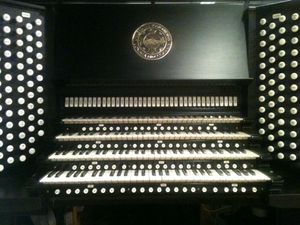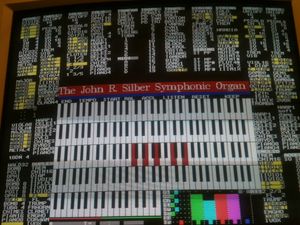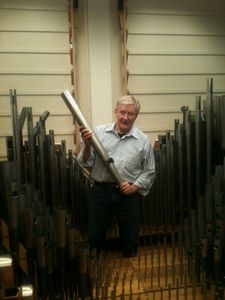I was walking out of the Dean’s Lounge in the GSU when I heard the organ. The vibrant and regal chords caught me off-guard and I decided not to rush to the ERC right away. If you aren’t sure what I am talking about, walk into Metcalf Hall on the second floor and look up. There you will see Boston University’s Symphonic Organ, which is the fusion of two player organs.
 Nelson Barden, BU’s organist and restorer-in-residence, appeared after the piece ended and he was happy to see a listener. I asked him what he had just played and he said it was “Go BU”.
Nelson Barden, BU’s organist and restorer-in-residence, appeared after the piece ended and he was happy to see a listener. I asked him what he had just played and he said it was “Go BU”.
I asked if I could record a piece and he gladly obliged. He produced a ladder that I could use to get a steady hand for an iPhone recording. Off he went to go press a button and out came the Third Movement from Tchaikovsky’s Symphony No. 6, Pathetique. Don’t let the “Pathetic” title dissuade you. It was a moving and intense performance for an audience of one.
According to Nelson, Dr. Metcalf, who was Chairman of the Board of Trustees from 1976 to 1994, wanted to preserve and combine two acquisitions and bring them to what is now Metcalf Hall: A 12-rank 1930 Skinner organ from the home of Percy A. Rockefeller in Greenwich, CT and a 23-rank 1930 Aeolian organ from the Winchester home of candy-maker William E. Schrafft.
 Shortly before Dr. Metcalf’s death in 1994, Nelson played Shubert’s March Militaire and the Battle Hymn of the Republic for Dr. Metcalf and BU Academy students. Dr. Metcalf, watching from the back row said, “This is what I always dreamed of; something for the kids. Something that would catch their attention.” Nelson and Dr. Metcalf always assumed the organ would become engrained into the university culture beyond simply an impressive restoration project.
Shortly before Dr. Metcalf’s death in 1994, Nelson played Shubert’s March Militaire and the Battle Hymn of the Republic for Dr. Metcalf and BU Academy students. Dr. Metcalf, watching from the back row said, “This is what I always dreamed of; something for the kids. Something that would catch their attention.” Nelson and Dr. Metcalf always assumed the organ would become engrained into the university culture beyond simply an impressive restoration project.
The keystone of the organ’s uniqueness is a computer known as the Boston University Symphonic Organ Recorder (BUSOR), which was installed in 1993. BUSOR was created because the player rolls became deteriorated every time they were fed through the organ. BUSOR’s editing power allows the player to unleash an endless stream of recordings. Music can be constructed on screen, which allows for stronger musicality than faded player rolls.
 Not many buildings these days come equipped with a fused 1920s symphonic residence organ with an original computer from 1916. It is quite a rare and wonderful machine that took 16 years to complete.
Not many buildings these days come equipped with a fused 1920s symphonic residence organ with an original computer from 1916. It is quite a rare and wonderful machine that took 16 years to complete.
If you’re here this summer, be sure you stop by Metcalf and listen to this marvelous instrument. Nelson will be here throughout the summer to work on organ maintenance and he hopes to offer more performances in the coming year. He also leads a group called the Friends of Boston University Symphonic Organ. If you’d like to learn more, send him an email at nbarden@aol.com.
Take a listen and come see this treasured piece of BU history!
-Patrick Devanney, Retention Program Specialist

2 Comments
????? ???? ??? posted on July 11, 2022 at 2:40 PM
Fantastic post.Really thank you! Fantastic.Loading…
spray nozzle posted on August 26, 2022 at 12:54 AM
BU’s Symphonic Organ | BU Educational Resource Center Blog